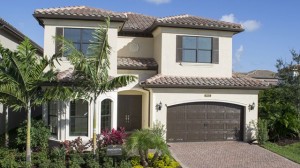Trending
Residential development mushrooms in PB County’s Agricultural Reserve

Palm Beach County’s Agricultural Reserve, once home to just farmland, has seen a major influx of housing development over the past few years — much to the consternation of environmentalists.
About 7,000 houses already have been built, mostly by GL Homes of Sunrise, in the 21,000 acres, and another 3,000 houses could be on the way. The Agricultural Reserve is bounded by Florida’s Turnpike to the east and the Loxahatchee National Wildlife Refuge to the west. Its northern border is unincorporated area west of Lake Worth, and its southern border is unincorporated area west of Boca Raton.
“Florida is saying goodbye to orange orchards and hello to new development in the western portion of South Florida,” Jack McCabe, CEO of McCabe Research & Consulting in Deerfield Beach, told The Real Deal.

A home in Valencia Cove
The homes are designed for wealthy families and retirees, with many priced above $1 million.
GL Homes’ projects include:
- Seven Bridges, located on Lyons Road north of Clint Moore Road. Homes there are priced at more than $1 million on average.
- Valencia Cove and Valencia Bay, located further north on Lyons Road. Homes there are priced between about $450,000 to more than $600,000. The projects include large clubhouses, restaurants, fitness centers and pools. They feature activity directors too.
- GL also has plans to construct 1,000 homes on 600 acres it possesses near Seven Bridges.
CalAtlantic Homes of Irvine, California and Ansca Homes of Boynton Beach also have projects in the Agricultural Reserve. All three developers were unavailable for comment.

A 4,700-square-foot Seven Bridges home
The rules of development for the Agricultural Reserve require builders to leave 60 acres untouched for every 40 acres they develop. But that’s not enough, environmentalists say. “That’s not adequate to preserve agriculture and open space,” Drew Martin, conservation chairman for the Sierra Club of Palm Beach, Martin and St. Lucie Counties, told TRD. “We aren’t keeping the tree cover, which is beneficial to the aquifer. There hasn’t been an adequate buffer between farms and homes.”
However, David Cobb, regional director for Metrostudy South Florida, has a different view. He sees what has happened in the Agricultural Reserve as a success. “Here’s an area where there’s multiple interests: protecting the environment and providing housing for a growing population in the county,” Cobb told TRD. “I’m sure neither environmentalists [nor] developers are happy, but it’s a compromise.”




